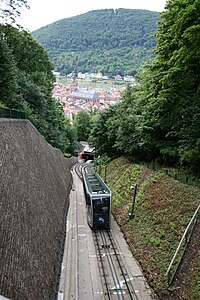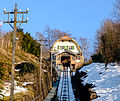Heidelberg mountain railway
| Heidelberg mountain railway | |||||||||||||||||||||||||||||||||||||
|---|---|---|---|---|---|---|---|---|---|---|---|---|---|---|---|---|---|---|---|---|---|---|---|---|---|---|---|---|---|---|---|---|---|---|---|---|---|
|
Molkenkurbahn above the Schloss middle station
| |||||||||||||||||||||||||||||||||||||
| Route number (DB) : | 94004 | ||||||||||||||||||||||||||||||||||||
| Route length: | Molkenkurbahn: 0.471 km Koenigstuhlbahn : 1.020 km |
||||||||||||||||||||||||||||||||||||
| Gauge : | 1000 mm ( meter gauge ) | ||||||||||||||||||||||||||||||||||||
| Power system : | 400 V ~ | ||||||||||||||||||||||||||||||||||||
| Maximum slope : | 430 ‰ | ||||||||||||||||||||||||||||||||||||
| Top speed: | 14.4 km / h | ||||||||||||||||||||||||||||||||||||
|
|||||||||||||||||||||||||||||||||||||
The Heidelberger Bergbahn , also Heidelberger Bergbahnen , is a combination of two funicular railways in Heidelberg . The “Molkenkurbahn” leads from the Kornmarkt on the edge of the old town past Heidelberg Castle to the Molkenkur . There you change to the “Königstuhlbahn” to the Königstuhl . The railways are operated by the local authority Heidelberger Straßen- und Bergbahn AG (HSB) and run on a track width of 1,000 millimeters . The difference in altitude between Kornmarkt and Molkenkur is 173 meters, the length of the route 454.6 meters and the pure travel time five minutes at a speed of five meters per second. On the Molkenkur – Königstuhl route, the difference in altitude is 260.5 meters, the route is 974.5 meters long and the journey time is nine minutes at a speed of two meters per second.
history
Planning and construction
Around 1873, plans began for a mountain railway up to Heidelberg Castle and the Königstuhl, which, however, repeatedly failed due to a lack of funds or failed property purchases. Early plans, including by the well-known Swiss mountain railway pioneer Niklaus Riggenbach , included a cog railway . It was not until the Leferenz brothers that the Heidelberg tram and mountain railway company Leferenz and Co., founded on March 23, 1885, was successful: Their license application from 1883 was approved on June 25, 1888, after the Heidelberger Schloßverein approved the city council in July 1885 and the student body objected. It was built from August 13, 1888 to November 16, 1889.
On March 30, 1890, the lower section of the Heidelberg mountain railway was opened, a funicular from Kornmarkt to Molkenkur, which has a middle station at the castle. The drive was initially carried out with water ballast . When the track opened, it had an additional rack for braking and regulating the speed of travel. The system was built by Maschinenfabrik Esslingen , the two cars were supplied by the local wagon factory Fuchs , which also manufactured tram cars for Heidelberg. In the first year of operation 189 904 passengers were carried.
In 1905, construction work began on the upper section of the mountain railway from Molkenkur to Königstuhl. The facility was built by Von Roll and opened on June 1, 1907. The wagons, which were also supplied by Waggonfabrik Fuchs, have been preserved to this day and have been in use again since March 2005 after a thorough renovation with adaptation to the latest safety regulations.
The lower runway was reopened in 1907 after a brief interruption in operations due to renovation work, as the water ballast drive was switched to the electric drive already used on the upper runway. The work was carried out by Von Roll , who also built the upper runway. Both railways ran without any problems worth mentioning in the following years, so that operations were only stopped due to force majeure such as energy shortages, war or changes in safety regulations.
Modern times and conversions
In the 1950s, a replacement by an escalator with a higher transport capacity to the castle was planned for the rapidly increasing tourism. Ultimately, preference was given to the mountain railway and so the old lower section of the mountain railway was shut down from September 24, 1961 to April 26, 1962 and a mountain railway corresponding to the state of the art at the time was built. The Kornmarkt and Schloss stations were also built using exposed aggregate concrete according to the taste of the time , which contrasted with the largely preserved old town. The HSB also built a parking garage above the Kornmarkt cable car station.
This time the wagons were delivered by the Rastatt wagon factory. The new lower mountain railway was put into operation in 1962.
Shutdown and reopening
In 2002, the State Office for Geology, Raw Materials and Mining Baden-Württemberg in Freiburg surprisingly ordered the closure of the upper mountain railway on April 30, 2003, as it no longer met the safety regulations of the European Union - which were changed after the Kaprun accident ; and this despite the fact that operational safety was confirmed during a revision in 2000. Although the operator tried to obtain an exemption in order to secure the operation at least over the summer season, this was refused. For this reason, the upper mountain railway ran at the end of April 2003 - initially - for the last time.
Thanks to a special permit, the lower mountain railway was allowed to continue operating until October 31, 2003. In spring 2004, however, their wagons were removed and scrapped. The wagons of the upper mountain railway were transferred to Switzerland, where they were thoroughly refurbished and carefully adapted to the latest safety regulations. They also got their historical paintwork again.
At the end of 2004 the new and larger wagons for the lower mountain railway were delivered and the refurbished wagons for the upper mountain railway also came back from Switzerland. The (two) mountain railways were put back into operation at the start of the season on March 24, 2005 and now meet the current safety regulations.
Monument protection
The upper mountain railway is the oldest funicular railway in Baden-Württemberg and, along with the younger Stuttgart funicular railway, the only one in which the original technology has been kept functional. In 2004 the upper mountain railway was registered in its entirety as a cultural monument of special importance in the monument book of the state of Baden-Württemberg .
gallery
Alternative point with Abt switch
literature
- Brigitte Neff: The Heidelberg mountain railways. Stations of romance. Regional culture publishing house, Ubstadt-Weiher 2006, ISBN 3-89735-458-6 .
Web links
- www.bergbahn-heidelberg.de
- http://www.standseilbahn.de/heidelberg/index1d.html with pictures from 2000
- http://www.standseilbahn.de/heidelberg/index2d.html with pictures from 2005
- A private website on the mountain railways documents the struggle to maintain the mountain railways from 2000 to 2005
- Bergbahn , regional council Stuttgart, State Office for Monument Preservation
Individual evidence
- ↑ a b c http://www.s197410804.online.de/Zeiten/1850.htm
- ↑ http://www.s197410804.online.de/Zeiten/1945.htm
- ^ Heidelberger Bergbahn - a cultural monument of particular importance. In: Stadtblatt, Official Gazette of the City of Heidelberg, No. 3/2005, p. 6 (PDF; 115 kB)









